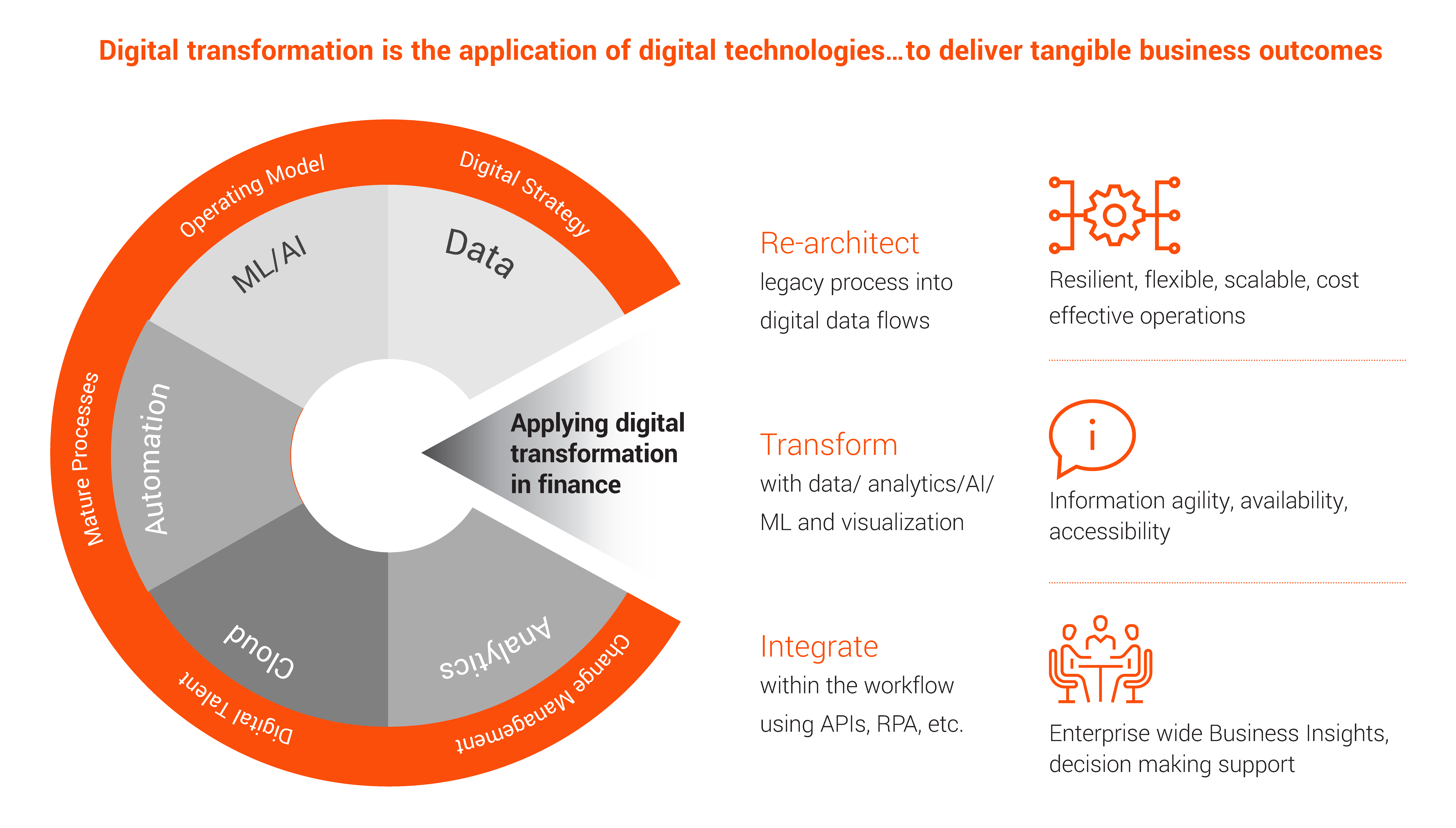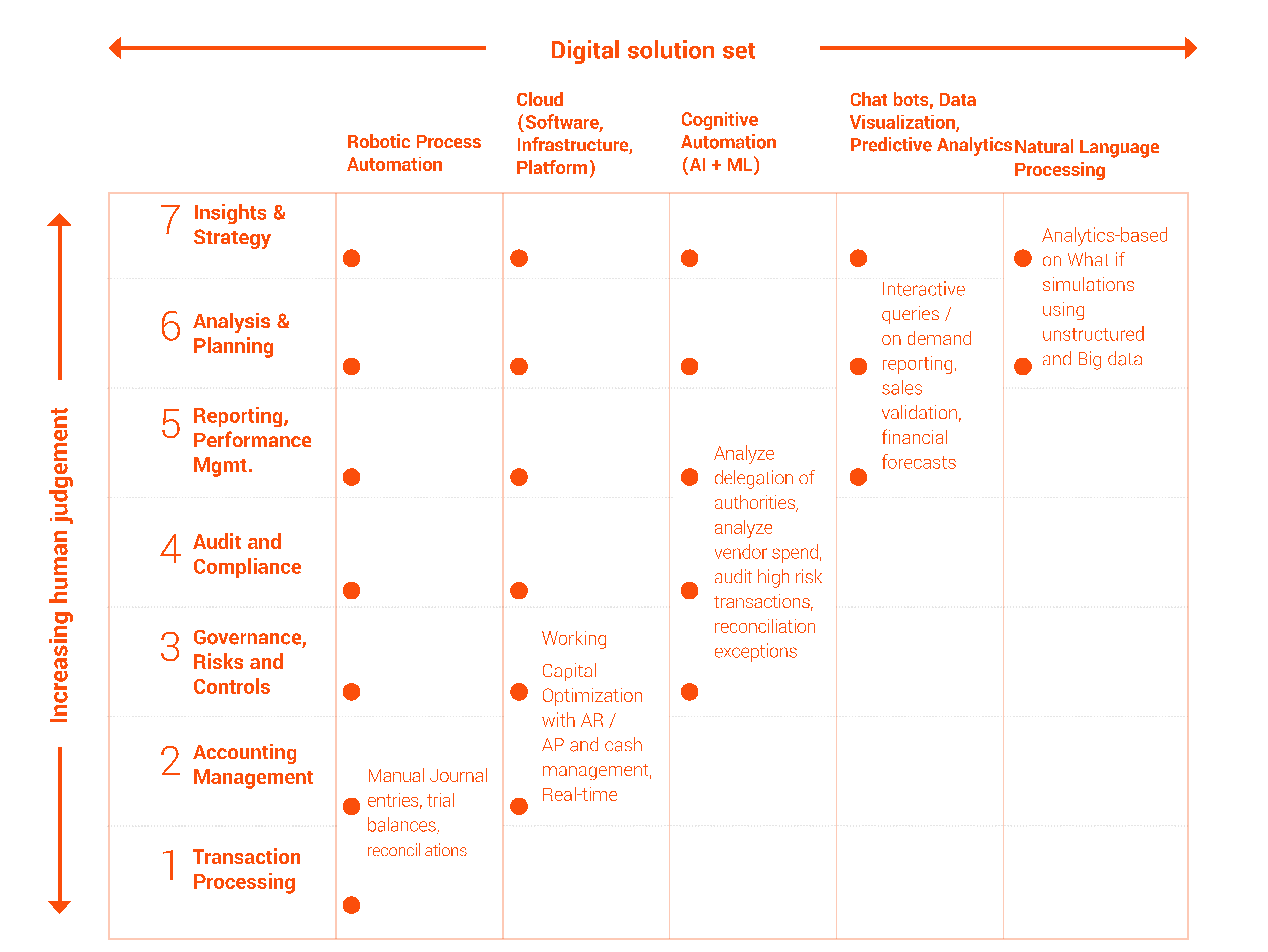Finance digital transformation in Insurance
At EXL, we are helping our clients adopt a more holistic approach to digital transformation by delivering solutions that orchestrate data, AI, and cloud capabilities to work seamlessly with existing technology footprint.
In many ways, the success of digital transformation initiatives in finance is mission critical for insurance CFOs.
There is extensive evidence that digitally mature finance functions – functions that have implemented more than a handful of finance digital transformation initiatives - are differentiating themselves on key performance metrics and are delivering superior results. Whether it is quality of business decisions, efficient reporting, or accurate planning and forecasting, they outperform finance functions that are still early in their digital transformation journey.
Digitally mature finance functions close the books faster, are proficient at responding and reacting quickly to change, and see better talent retention.
Most insurance finance functions are either in the early stages of their digital transformation journey or have not started at all. Even in organizations that have made significant progress, the adoption of digital technologies is largely limited to transactional processes.
Most current transformation challenges are common across the industry and have been difficult to overcome. Data availability
To EXL, digital transformation is the application of digital technologies, data management tools, and analytics solutions to improve the performance and efficiency of end-to-end finance processes.
and usability continues to be an obstacle, digital talent is hard to find and harder to retain, and efforts to upskill existing talent comes with difficulties. It can be difficult to generate enthusiasm for these initiatives, as many people will look upon them as another technology trend that may not survive the next implementation.
At EXL, we are helping our clients adopt a more holistic approach to digital transformation by delivering solutions that orchestrate data, AI, and cloud capabilities to work seamlessly with existing technology footprint. Our approach focuses on putting AI solutions such as natural language processing (NLP), image processing, and document extraction as upstream in a process path as possible, creating a foundation for enabling downstream efficiencies. Next, we redesign processes to enable AI-powered data flows with embedded analytics, eliminating unconnected data silos and generating insights across the workflow. For legacy and hard to integrate technology applications, our solutions leverage cloud services or low–code workflow tools to enable a shift to best-of-breed infrastructure with seamless third party integration. Finally, and probably the most critical piece is to enable digital talent through focused learning and development to maximize the benefits of digitally transformed finance function.
Putting digital in digital finance
One of the questions the finance industry is grappling with is this: what exactly is digital finance? To a certain extent, the term digital finance could apply to every application, process and business model that can transform the finance organization. To EXL, digital transformation is the application of digital technologies, data management tools, and analytics solutions to improve the performance and efficiency of end-to-end finance processes. It’s enabled by foundational prerequisites such as clearly defined strategy, digital talent, mature processes, change management, and hybrid operating models.
Digital transformation is also heavily reliant on data. We have seen several examples where finance organizations attempt to transform through a piecemeal approach, only to realize that the latest technology implementation is only as good as their data quality. This, too, requires a transformative approach.

While no two organizational paths are the same, in this paper, we lay out a model step-by-step approach on how to orchestrate the digital transformation journey while capturing the business benefits along the way.
Why digital transformation is difficult?
Most insurance companies struggle to move beyond the technology pilots and scale to meaningful business impact due to the following challenges.
- Managing data is still cumbersome: Most insurance companies, especially global organizations with broad product portfolios need governance, standards, and policies to ensure consistent definitions, storage and ownership of data. Lack of organizational alignment and dedicated resources results in multiple data sources that require considerable manual effort to consolidate. In many cases, data when available is either not at the required level of detail or is not of acceptable quality. On top, growing data volume and expanding CFO role are creating demands for complex analysis and insights, that most finance functions cannot simple meet.
- Simple automation benefits are lower than expected: A significant proportion of CFOs are experimenting with automation applications to reduce manual effort and create capacity. This trend has accelerated over the past year as part of the work-from-anywhere staffing model. However, few automation initiatives have met or exceeded initial expectations in terms of business benefits. In most cases such programs focus on exclusively cost savings, limiting the business case to transactional processes. By not including data and analytics capabilities into an automation business case, finance functions are missing on the full potential of these technologies.
- Cloud applications are promising but risks remain: Cloud technologies are certainly on the radar of the finance functions. Most finance leaders are considering adopting cloud-based technology in some form or another. Cost efficiencies are a leading driver, along with access to information, scalability, efficiency and ease of integration across platforms. However, cyber security remains a concern. There are solutions worth investigating, such as private cloud, but it may be that it takes some time to develop adequate comfort for the finance function to adopt cloud-based solutions.
- Digital talent is scarce: Working with digital technologies requires skills that are different from what is available in a typical insurance finance function. In a digital ecosystem, finance teams must be able to work with large datasets, troubleshoot bots for exception management, and use analytical models. Without such skillsets, the finance function becomes dependent on external COEs for such services, resulting in an inefficient operating model with multiple hand-offs and unclear ownership. Finding and attracting such talent is hard, and upskilling an existing workforce with such capabilities can take significant effort. In a worst-case scenario, new digital capabilities are retrofitted to existing processes, limiting any potential benefits. Developing finding the right talent solution will not only increase the success rate of digital transformation, but also help retain and develop talent that is ready for the future of digital finance.
Success of digital transformation hinges upon the prerequisites of strategy, talent, processes, maturity, change management and operating models.
How to enable successful digital transformation in finance?
Success of digital transformation hinges upon the prerequisites of strategy, talent, processes, maturity, change management and operating models. These are all integral components for setting up a successful digital transformation program. The key differentiator between finance teams who successfully transform their operations digitally and those that fail is that successful leaders do not just focus on implementing technologies, but also equally prioritize strategic enablers to ensure that the organization and employees embrace and adopt the digital transformation. The executive leadership must ensure that finance strategy is clear, and communicated across the organization at every level to evangelize digital adoption. It’s imperative for processes to be reexamined with a digital lens for maturity, and that the talent is upskilled to maximize their potential with new digital solutions as they are embedded into finance operations.
-
Set the strategic objective and align goals
Every digital transformation strategy and outcome must contribute towards organizational objectives and requires the executive leadership’s buy-in. Effective change management and support from the top of the organization helps move the function along the maturity curve and encourages adoption, which is a critical contributor to the success of any transformation initiative. This is especially vital now to address employee concerns. The keys to success in this area are training and consistent communication.
Consider accelerating digital transformations as part of the return-to-office strategy, especially if considering a hybrid model with remote work schedules embedded into the future operating models.
Protect growth and profitability through actions such as scenario planning, more frequent financial modeling exercises to improve resiliency, and new models.
Take the pulse of your customers, thinking through longer-term considerations around shifts in core markets or business models.
-
Stand up a bespoke operating model
Selection of an operating model must be done according to the size, maturity, and scale of the organization to enable efficacy across the full delivery lifecycle. The right operating model supports scale and speed when deploying digital solutions across the organization.
This operating model should include a robust delivery, service, support, and maintenance model in order to ensure few to no outages for digitally enhanced finance operations. This maintains business continuity while meeting defined goals, building confidence in the program. The digital talent quotient should also be enhanced to ensure employees realize the benefits of transformation. They should be regularly trained to take advantage of the technology solutions and re-engineered processes.
-
Start small, scale fast
To execute on the strategy, it is important to validate the preliminary ideas and hypotheses for the solution. Pilot candidates that will yield fast results should be identified to test these hypotheses before implementing any full-scale digital solutions. Once the pilot solutions have been validated, the focus should immediately shift to establishing the structure, operating model, and center of excellence. A defined governance, demand intake, and qualification process is a key upfront activity that will empower insurers to prioritize implementing a digital workforce in the most important areas.
Transactional processes such as manual journal entries, trial balances, reconciliations are ideal candidates to begin these initial pilots. Additionally, migrating finance systems, such as ERPs, to the cloud complements the automation of transactional processes with built-in automation features. It also creates a better ability to integrate with latest automation technologies. Streamlined data accessibility in the cloud is an additional positive. As successive cloud migrations centralize more and more data, the digital levers become more productive in generating better financial insights such as working capital optimization, cash management, and treasury forecasting with near real-time recommendations.
Few organizations work on implementing intelligent automation solutions to improve the quality of data upstream in the process. Once the data is structured and digitized upstream, downstream automation is much more effective. Upstream automation of data ingestion and data enhancement also allows companies to create data flows that support embedded analytics and reduce manual processing.
However, RPA and cloud still only touch about 50% of the finance activities. Hence, from a digital perspective, the finance leaders need stronger, more comprehensive technology enablers to move further along the journey in order to see more transformative results and benefits.
-
Technologies must work together to orchestrate success
Using digital technologies in isolation will only take the finance function so far. As processes become more complex and begin to include more and more human judgement, it usually takes more than one technology to have a demonstrable impact. Evaluating data is a very powerful starting point. However, it’s also important to look at the role and potential of analytics and intelligent automation along with robotics, machine learning (ML), AI, and cloud technologies. When applied together to enable end-to-end digitization of the finance operations, the synergies, value, and business outcomes generated compound.
Robotics and cloud technologies, when combined with a broader set of capabilities such as AI, ML, and natural language processing (NLP), can potentially automate more than 80% of all finance activities.
For example, analyzing vendor spend or auditing high-risk transactions can be done real-time instead of sample-based controls. However, this requires more than just robotics. Digitally enhanced finance controls may adapt dynamically based on ML-model suggested controls, KPIs, and thresholds based on historical behavior, making it contextually aware and able to operate real time. Some companies have predictive models in the cloud that need to use unstructured data, requiring NLP in order to integrate and analyze data to produce insights and understanding, identify underlying patterns in financial data to predict scenarios and improve business outcomes. Organizations have been deploying such solutions in generating their demand forecasts, analyzing sales validations, and generating insights by leveraging predictive data models coupled with other technologies. Integrating such solutions with a chat-bot provides an intuitive user interface/agent to the finance teams for planning and consolidation solutions with dynamic BI reports, simulation and insights based on data analytics for performance analysis
-
Measure and iterate
It’s important to measure performance to check the delivered value of digital transformation. Reviewing and realigning performance targets in view of the immediate requirements, such average handling time, capacity gains, strengthened audit controls, and others will provide a view into the success of digital initiatives. Continuous improvement is crucial to attaining the desired business outcomes.

Case Study – A Fortune 50 life and annuity insurance company
EXL Services transforms finance operations for a large insurance company and redefines its work- force with digital suite
A large insurance company realized that the repetitive, manual tasks its employees performed were taxing their ability to nurture long-term human relationships. It sought to eliminate such tasks, reengineer processes and realign human capital with strategic activities by digitally transforming the finance operations. Success would reduce processing time - close the books faster, optimize processes - minimize rework, promote continuous talent upskilling - better retention, and improve operating margins while enabling scale to support business growth - proficient at responding and reacting quickly to change.
The client partnered with EXL for its digital transformation. EXL leveraged its proprietary tools and methodologies to fast track the automation and demonstrated a comprehensive, future-ready approach. EXL adopted a multi-pronged approach to institutionalize industry best practices to enable digital transformation at scale. EXL helped establish a center of excellence with a storehouse of reusable digital toolkit, and professionals to expand the effort into other organizational functions. EXL identified pilot process automations, immediate areas for improvement, applied intelligent automation solutions to the task, and helped establish a “Bot Factory”, resulting in cumulative savings of ~$2MM projected over five years. The factory was responsible for implementations in upcoming processes, continuous improvement, bot maintenance plus change management and continued governance. The client started with a centralized operating model that managed end to end automation activities for all business partners. As the governance, quality controls, standards and processes matured, EXL is enabling the client to gradually evolve into federated operating model to drive digital transformation with business units depending upon their requirements, maturity level, and ability to scale up across the enterprise.
EXL’s best practices and standards helped to improve solutions throughout the implementation. Manual processes were minimized, thereby reducing human errors and ensuring seamless integration within multiple disparate systems. EXL identified 31,000 capacity hours gained across several processes, and scalability for tens of thousands more resulting in cumulative savings of $8MM over five years. EXL’s discovery efforts identified more than 80 opportunities in different F&A functions requiring data and insights with AI, ML, and data analytics. The client also initiated the cloud migrations for their finance systems that compounded the benefits of both the programs. Business outcomes were aligned with the client’s strategic objectives throughout the opportunity identification process. The project helped the client by providing faster process turnaround time, significant time savings (up to 88 percent) and risk reduction through improved audit sample size. It resulted in happier employees, increased productivity and enhanced customer experiences.

Written by:
Vikrant Saraswat
Partner, Finance Transformation, Insurance
Amit Dhawan
Asst. Vice President, Digital Transformation
